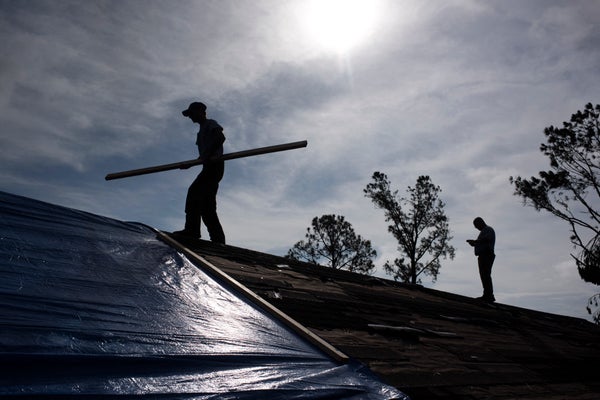Successive Disasters Put U.S. Gulf States at Risk of a ‘Knock-Out Blow’
Repeated extreme weather events in states along the Gulf of Mexico such as Louisiana, Alabama, Texas, Mississippi and Florida can erode a community’s ability to take care of itself

Workers put tarps on a roof in Little Caillou, near Montegut, Louisiana on August 30, 2021 after Hurricane Ida made landfall.
Mark Felix/AFP via Getty Images
CLIMATEWIRE | A cycle of “perpetual disaster recovery” threatens to drag down states along the Gulf of Mexico as climate change adds to the danger of overlapping extreme weather events, a new report finds.
Researchers affiliated with the National Academies looked at compound disasters that hit the Gulf region between 2020 and 2021. Those included seven hurricanes and one winter storm that each caused more than $1 billion in damages.
The steady stream of disasters landed especially hard on communities who — after generations of disinvestment amid systemic racism — lacked the resources to absorb the damage or recover quickly, according to analysis released Wednesday by the National Academies of Sciences, Engineering and Medicine.
On supporting science journalism
If you’re enjoying this article, consider supporting our award-winning journalism by subscribing. By purchasing a subscription you are helping to ensure the future of impactful stories about the discoveries and ideas shaping our world today.
“Consequently, perpetual disaster recovery, coupled with increasing disaster risk, is an enduring reality for many living in [Gulf of Mexico] communities,” according to the report, which was sponsored by the Gulf Research Program, established as part of the legal settlement from the 2010 Deepwater Horizon oil spill.
The Gulf’s experience shows that officials need to rethink fundamental aspects of recovery, wrote the team of authors, who hail from the insurance sector, emergency management and academia.
“For too long, America responded to disasters as singular, isolated events,” said Roy Wright, chair of the committee that wrote the report and president and CEO of the Insurance Institute for Business and Home Safety.
“Individual disasters do not occur in isolation amid a community’s history,” he said in a statement. “With each successive punch of overlapping disaster recoveries, the vulnerabilities increase. This heightens the risk that the next event could provide a knock-out blow. These are compounding disasters.”
Disasters should be viewed as an “epoch,” the report argues, rather than an individual event. “An event-driven view focuses on the symptoms rather than the root causes of disaster losses.”
During listening sessions held around the Gulf and virtually, the authors wrote, “participants continually reported that the impacts of discrete disaster events were impossible to disentangle when the disasters occurred in such rapid succession and their recovery time lines overlapped,” the researchers wrote.
One of the region’s central problems is that governments depend on community organizations for disaster recovery.
By their nature, the authors wrote, compound disasters erode a community’s ability to take care of itself. One of the main ways that happens is worsening the mental health of a community — especially first responders and volunteers.
The people who comprise community organizations “consistently reported feeling burned-out and overwhelmed from spending long hours providing physically and/or emotionally taxing labor for little compensation,” according to the study.
Those volunteers and organizations are essential to both disaster response and recovery, the authors wrote, but they might not be able to assist when they’re most needed if they’re suffering the impacts of compound disasters themselves.
“Overreliance on this often uncompensated or underpaid workforce,” the study says, “risks the depletion of critical human resource capacity for effective long-term recovery from successive disasters.”
Bureaucratic challenges also follow overlapping disasters. After a pair of hurricanes hit Louisiana and Alabama in rapid succession, residents and officials struggled to distinguish which damage was linked to which storm. That caused problems recovering, according to the report, as insurance companies and government agencies delayed or denied reimbursements and assistance.
The study notes that improvement is possible: When a community becomes more resilient, recovery is quicker and less taxing — which reduces the odds of disasters compounding on top of each other. That includes more medical and public health staff, as well as more resilient infrastructure.
Some communities can afford to do that preemptively. But poorer ones, the report notes, might only be able to afford that with recovery funds — after damage already has occurred.
Reprinted from E&E News with permission from POLITICO, LLC. Copyright 2024. E&E News provides essential news for energy and environment professionals.
